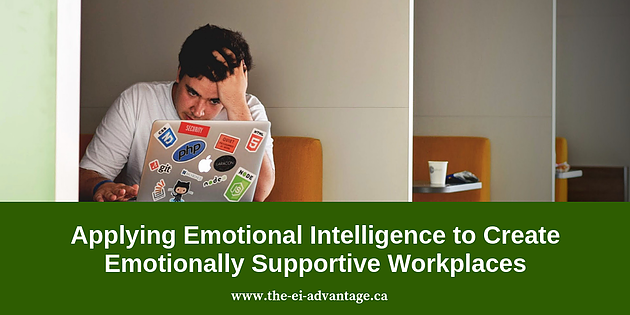Blog
Applying Emotional Intelligence to Create Emotionally Supportive Workplaces
September 13, 2018

Our workplaces are more demanding than ever before. With executive burnout and derailment at an all-time high, it’s clear that our work is starting to take a serious toll on both our workplace and personal well-being. This trend is so pervasive that Harvard Business Review calculated that burnout is costing workplaces approximately $190 billion a year in healthcare spending in the United States, alone.
However, in order to understand the root of professional burnout we need to look at what businesses are doing to combat the issue, where they’re failing, and how investing in Emotional Intelligence development can enhance both workplace and personal well-being.
Consider these trends in the modern workplace: offices are investing in on-site fitness centers, providing healthy snacks in break rooms, and challenging staff with cycling, walking, and weight loss challenges.
What’s missing from these examples? If you guessed “investment in mental well being” then you’d be correct! What’s missing is that businesses are jumping on the trend of focusing on physical well-being, while unintentionally ignoring how they can enhance their employee’s personal and professional well-being.
Applying a Holistic Approach to Well-Being
A study from Gallup found that participation in workplace physical wellness programs is about one in four, but that these programs are under-producing in terms of delivering tangible benefits to employees due to a lack of focus on broader wellness issues, such as emotional well-being and mental health.
We’ve pulled the data from the Gallup study and have identified five critical ways that businesses can take a “coach approach” to employee well-being:
- Financial well-being
- Social well-being
- Purpose well-being
- Physical well-being
- Community well-being
When workplaces focus on delivering programs that focus on the elements above, they ultimately promote supportive relationships, financial well-being, community participation, and making healthy choices. Additionally, they encourage values and activities that make day-to-day life and work experiences more fulfilling for their staff.
Is Your Staff Thriving, Struggling, or Suffering? How to Find Out:
In order to determine where to apply your “coach approach” first, consider the five points we listed above and ask yourself where your team members fall in each of the five categories. Are they:
Thriving: Is each team member consistent, motivated, and do they feel positively about this core point?
Struggling: Does the team member have issues with one of the five core points?
Suffering: Might the team member be inconsistent in getting things done, or do they appear unmotivated?
According to the Gallup research, 28% of adults aged 18 and older in the U.S. are not “thriving” in any of these areas, with only 7% reporting that they are thriving in all five areas. Think about this another way: for every one person who is thriving, there are 13 who are struggling to improve several areas of their personal and professional well-being.
Furthermore, it’s not enough to ensure that your staff are thriving in only one area. In fact, Gallup’s study concluded that individuals who were “thriving” in only physical well-being still exhibit these behaviours:
- They’re 3x more likely to file a workers’ compensation claim.
- They’re 26% less likely to fully bounce back after a hardship.
- They still miss 68% more work annually due to poor health.
- They’re 5x more likely to find a new job in the next year, and are 2x more likely to change jobs.
- They’re less than half as likely to be adaptable to change at work.
The fastest way to begin implementing emotional intelligence strategies in order to enhance workplace and personal well-being for your team members is to integrate Emotional Intelligence (EI) strategies into your training.
Here are two approaches to get you started:
Use Employee Strengths
When employees face challenges and are using their strengths in the workplace they report higher levels of workplace engagement. Also, being challenged to use one’s strengths every day helps to reduce work-related stress and increases job and life satisfaction.
With this in mind, it’s important to coach for strength awareness and utilization in your company, because not only will you ensure that your staff experience high levels of well-being at work, but also that they feel inspired to put in the time and effort needed to increase the business’s bottom line.
Invest in Emotional Intelligence Training
There’s overwhelming research that supports the claim that emotional intelligence has a significant impact on workplace and personal well-being. This is true for all employees, not just those in the C-suite! By educating employees on emotional intelligence and employing assessments such as the EQ-i 2.0 assessment in the workplace, you will be creating mindfulness and helping to strengthen your employees’ mental wellbeing, and ultimately, your bottom line.
By helping your team members be more aware of their emotions and how they react to change, we can empower them to take positive steps in both their personal and professional well-being.
For more information and tips on how to coach for strengths and emotional intelligence to create a workplace well-being culture, subscribe to our newsletter or contact us today.
